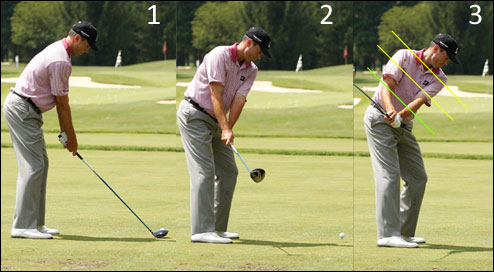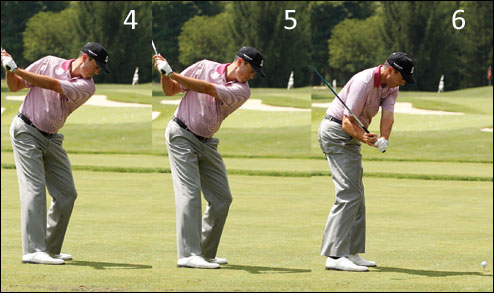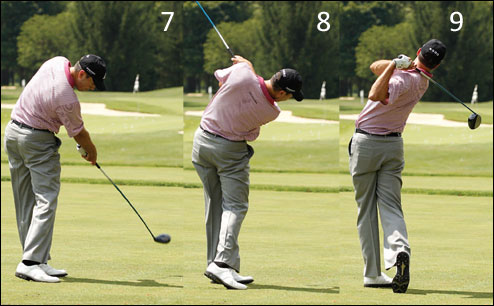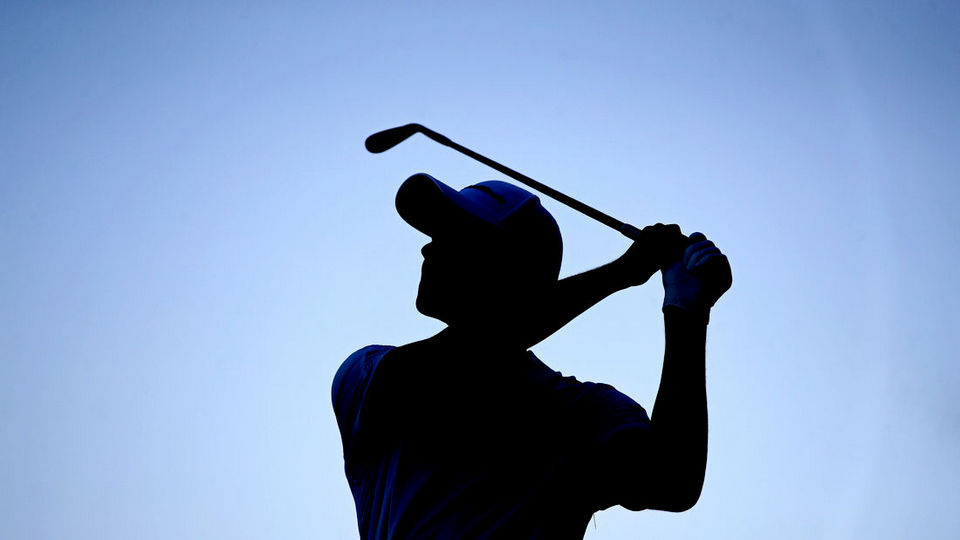Tuition
The Plane Truth
Part 4 - Matt Kuchar - Natural Born One Plane Golf Swing
Part 1 - Plane Talk - Interview with golf swing coach Jim Hardy
Part 2 - The Matrix & My Profile - A revolutionary vision for online golf instruction
Part 3 - One & Two Plane Golf Swings - A rough guide
Part 4 - Matt Kuchar - Natural Born One Plane Golf Swing
Part 5 - Leading Plane Truth certified pros in the UK give their verdict
Part 6 - In three balls you could cure your slice

So, when we started working together in 2006, we initially worked on steepening his swing (and I know that will come as a surprise to a lot of you looking at this sequence!), focusing on 'arms in, club out' at the start of the motion. His left arm has always wanted to work tight across the chest, which I like. I've heard Butch Harmon commentating on Sky Sports say that Matt is 6' 4” swinging at 5' 9” – and he's on the money. Matt's swing appears to be extremely flat, partly because he is so tall.

2) ‘Arms in, club out’ gets the first move taken care of. The upper left arm is on the chest, while the clubface is square to the plane.
3) Shoulders, biceps and forearms all in parallel planesFrame 1: A good set-up position. He's bent over from the hips and the arms just hang comfortably, all pretty good and not much more you can say about that. Given his height, Matt needs to bend over to reach the ball.
Frame 2: To make the first move we focus on the arms swinging in with the right arm still on top of the left ('arms in, club out'). Looking at the club face some people would regard this as being shut, but actually it's square to the plane of the swing. [Matt used to swing the club to the inside a lot more in the early stages, rolling the forearms and getting the shoulders too flat. Hence we work on keeping the left arm low and tight, right arm on top, so the shoulders stay steep. Proof of that is clear in frame 3, where you can see how steep the shoulders are – you don't see that shoulder angle with most guys.]
Frame 3: His left arm is simply moving further across his chest, the club is starting to rotate a little bit and in frame 4 we see the left arm is low and tight, his right elbow up and behind him. If the right elbow stays low and in front it holds the right shoulder down and makes it too flat.

5) Note that while he makes a full coil, turning his shoulders through a full 90 degrees, the lower body is resisting
6) Left knee and left hip re-rotate and pull back and out of the way to allow Matt to turn through while maintaining his posture.Frame 5: is just beautiful – a pure one-plane with the left arm in the same plane as his shoulder angle, right elbow is behind him. His hands are well behind his shoulder – compare with a classic Two Plane swing, like Tom Watson's, and you will see the hands are on top of the right shoulder. So his hands are way behind him and the clubface is a slightly closed due to Matt's strong grip.
We have worked a lot on the way his hips move in the backswing to influence the way they then react in the downswing. We are trying to get the right hip to move back behind so that the shoulders go steep. In the down swing we then work on pulling the left knee and the left hip back, which allows him to stay in his spine angle (before the left hip would remain static as he thrust with the right and the spine would come up). He keeps his body angles very well, especially when you consider this is a a driver. In frame 7 the left leg is leaning back – it's not perpendicular.

The clubface is very stable to the arc through frames 6 and 7 (i.e. up to and including the hitting area). In frame 8 it's rolled over – once he gets past hip high in the through-swing it's going to roll over on the way to the finish, which he holds in perfect balance.
I wouldn't say Matt Kuchar is a model 'One-Planer' – our style of teaching doesn't recognise a model, as such. But what makes Matt a true One-Planer is the fact that he sees golf as a game where you swing your arms around your body. At the top of his backswing, the left arm is right in the same plane as his shoulder plane. The question you have to ask yourself is are you naturally someone who likes to swing around or are you a more upright hands and arms swinger, like a Colin Montgomerie?
A One-Plane swing is more difficult to learn, but requires less maintenance; a Two-Plane is easier to learn, but relies on timing requiring more maintenance.



